A Reliability Analysis Framework of Ship Local Structure Based on Efficient Probabilistic Simulation and Experimental Data Fusion
Abstract
:1. Introduction
2. Reliability Analysis Framework
2.1. Cross-Deck Structure
2.2. Efficient Probabilistic Simulation and Bayesian Update
3. Efficient Probabilistic Simulation
3.1. Probability Parametric Modeling
3.2. Surrogate Model
3.3. Ultimate Strength Uncertainty Quantification
4. Test of Box Girder Structures for Ultimate Strength
4.1. Test Specimen and Test Purpose
- To obtain the failure path of the structure;
- To obtain the influence characteristics of uncertain factors;
- To verify the reasonability of the selection of reliability analysis parameters.
4.2. Test Process
4.2.1. Initial Defect Measurement
4.2.2. Test Equipment
4.3. Credibility of Test
4.4. Data Fusion Using Bayesian Updating
4.5. Analysis of Test and Comparison with Simulation
5. Reliability Analysis
5.1. Limit State Equation
5.2. Load Design
5.3. Local Safety Factor Calculation
6. Discussion on Limitations of Framework
7. Conclusions
Author Contributions
Funding
Data Availability Statement
Acknowledgments
Conflicts of Interest
References
- Leveson, N.G. Engineering a Safer World; MIT Press: Cambridge, MA, USA, 2012. [Google Scholar]
- Ayyub, B.; Assakkaf, I.; Sikora, J.; Adamchak, J.; Atua, K.; Melton, W.; Hess, P. Reliability-Based Load and Resistance Factor Design (LRFD) Guidelines for Hull Girder Bending. Nav. Eng. J. 2002, 114, 43–68. [Google Scholar] [CrossRef]
- Deng, L.; Zou, L.; Tang, W.; Fang, C. Reliability analysis of longitudinal strength of inland river ships and optimization of sub-item safety factors. In Proceedings of the 2017 Outstanding Academic Papers of the Chinese Society of Naval Architects and Marine Engineers, Wuhan, China, 1 July 2016; pp. 13–20. (In Chinese). [Google Scholar]
- Zhu, L.; Pan, M.; Zhou, H.-W.; Das, P.K. Transverse Strength and Reliability Assessment on Ore Carrier Cross-Deck Structures. In Proceedings of the 27th International Ocean and Polar Engineering Conference, San Francisco, CA, USA, 25–30 June 2017. [Google Scholar]
- Yongkun, Z.; Xin, G. Research on the ship local structure damage subjected to underwater explosion. In Proceedings of the 2017 29th Chinese Control And Decision Conference (CCDC), Chongqing, China, 28–30 May 2017; pp. 6113–6117. [Google Scholar]
- Zhang, S. A review and study on ultimate strength of steel plates and stiffened panels in axial compression. Ships Offshore Struct. 2015, 11, 81–91. [Google Scholar] [CrossRef]
- Nordsenstrom, N. Probability of Failure for Weibull Load and Normal Strength; Det Norske Veritas: Berum, Norway, 1969. [Google Scholar]
- Mansour, A. Methods of Computing the Probability of Failure Under Extreme Values of Bending Moment. J. Ship Res. 1972, 16, 113–123. [Google Scholar] [CrossRef]
- Mansour, A.E. Probabilistic Design Concepts in Ship Structural Safety and Reliability. Trans. SNAME 1993, 80, 64–97. [Google Scholar]
- Caldwell, J.B. Ultimate longitudinal strength. Trans. Roy Inst. Naval. Arch. 1965, 107, 411–430. [Google Scholar]
- Vhanmane, S.; Bhattacharya, B. Estimation of ultimate hull girder strength with initial imperfections. Ships Offshore Struct. 2008, 3, 149–158. [Google Scholar] [CrossRef]
- Kim, D.K.; Park, D.K.; Kim, H.B.; Seo, J.K.; Kim, B.J.; Paik, J.K.; Kim, M.S. The necessity of applying the common corrosion addition rule to container ships in terms of ultimate longitudinal strength. Ocean. Eng. 2012, 49, 43–55. [Google Scholar] [CrossRef]
- Van Vu, H.; Sang-Rai, C. Generate the Ultimate Longitudinal Strength of Damaged Container Ship Considering Random Geometric Properties under Combined Bending Moment. In Proceedings of the 2nd Annual International Conference on Material, Machines and Methods for Sustainable Development, Cham, Switzerland, 12–15 November 2020; pp. 495–501. [Google Scholar]
- Zhao, N.; Chen, B.-Q.; Zhou, Y.-Q.; Li, Z.-J.; Hu, J.-J.; Soares, C.G. Experimental and numerical investigation on the ultimate strength of a ship hull girder model with deck openings. Marine Struct. 2022, 83, 103175. [Google Scholar] [CrossRef]
- Xu, M.; Song, Z.; Zhang, B.; Pan, J. Empirical formula for predicting ultimate strength of stiffened panel of ship structure under combined longitudinal compression and lateral loads. Ocean. Eng. 2018, 162, 161–175. [Google Scholar] [CrossRef]
- Xia, T.; Yang, P.; Song, Y.; Hu, K.; Qian, Y.; Feng, F. Ultimate strength and post ultimate strength behaviors of hull plates under extreme longitudinal cyclic load. Ocean. Eng. 2019, 193, 106589. [Google Scholar] [CrossRef]
- Echard, B.; Gayton, N.; Lemaire, M. AK-MCS: An active learning reliability method combining Kriging and Monte Carlo Simulation. Struct. Saf. 2011, 33, 145–154. [Google Scholar] [CrossRef]
- Shi, X.; Teixeira, Â.P.; Zhang, J.; Soares, C.G. Kriging response surface reliability analysis of a ship-stiffened plate with initial imperfections. Struct. Infrastruct. Eng. 2014, 11, 1450–1465. [Google Scholar] [CrossRef]
- De Baar, J.; Roberts, S.; Dwight, R.; Mallol, B. Uncertainty quantification for a sailing yacht hull, using multi-fidelity kriging. Comput. Fluids 2015, 123, 185–201. [Google Scholar] [CrossRef] [Green Version]
- Bichon, B.; Eldred, M.; Swiler, L.; Mahadevan, S.; McFarland, J. Efficient Global Reliability Analysis for Nonlinear Implicit Performance Functions. Aiaa J. AIAA J. 2008, 46, 2459–2468. [Google Scholar] [CrossRef]
- Pan, M.; Zhu, L.; Kumar, D.P. Structural reliability assessment on cross-deck structures of ore carrier (in Chinese). J. Ship Mech. 2020, 24, 118–126. [Google Scholar]
- Sacks, J.; Welch, W.J.; Mitchell, T.J.; Wynn, H.P. Design and analysis of computer experiments. Stat. Sci. 1989, 4, 409–423. [Google Scholar] [CrossRef]
- Simpson, T.W.; Poplinski, J.; Koch, P.N.; Allen, J.K. Metamodels for computer-based engineering design: Survey and recommendations. Eng. Comput. 2001, 17, 129–150. [Google Scholar] [CrossRef] [Green Version]
- China Classification Society. Materials and Welding Specifications; China Classification Society: Beijing, China, 2021. [Google Scholar]
- Perrin, F.; Sudret, B.; Pendola, M. Bayesian updating of mechanical models—Application in fracture mechanics. In CFM 2007—18ème Congrès Français de Mécanique; AFM, Maison de la Mécanique: Courbevoie, France, 2007. [Google Scholar]
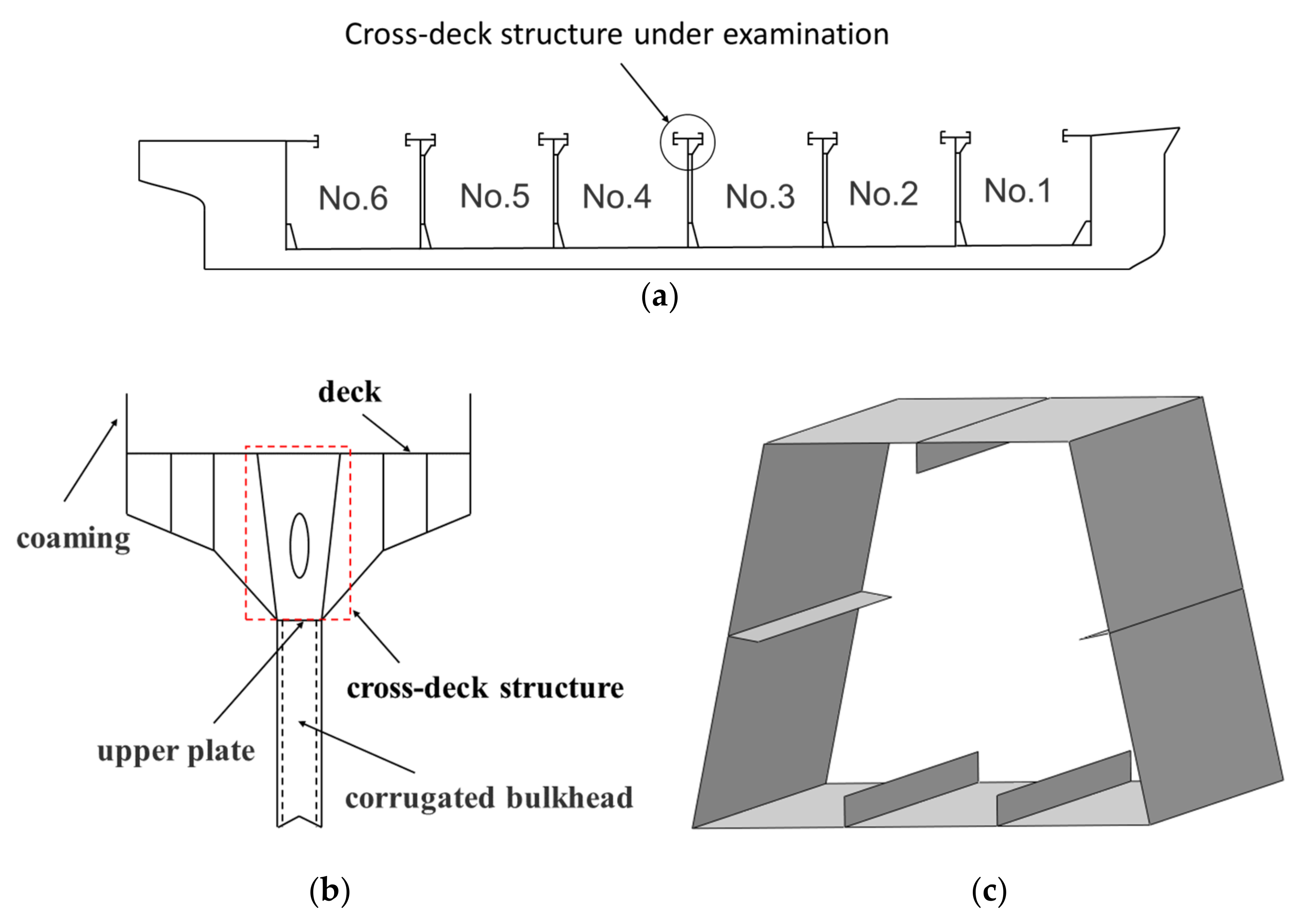
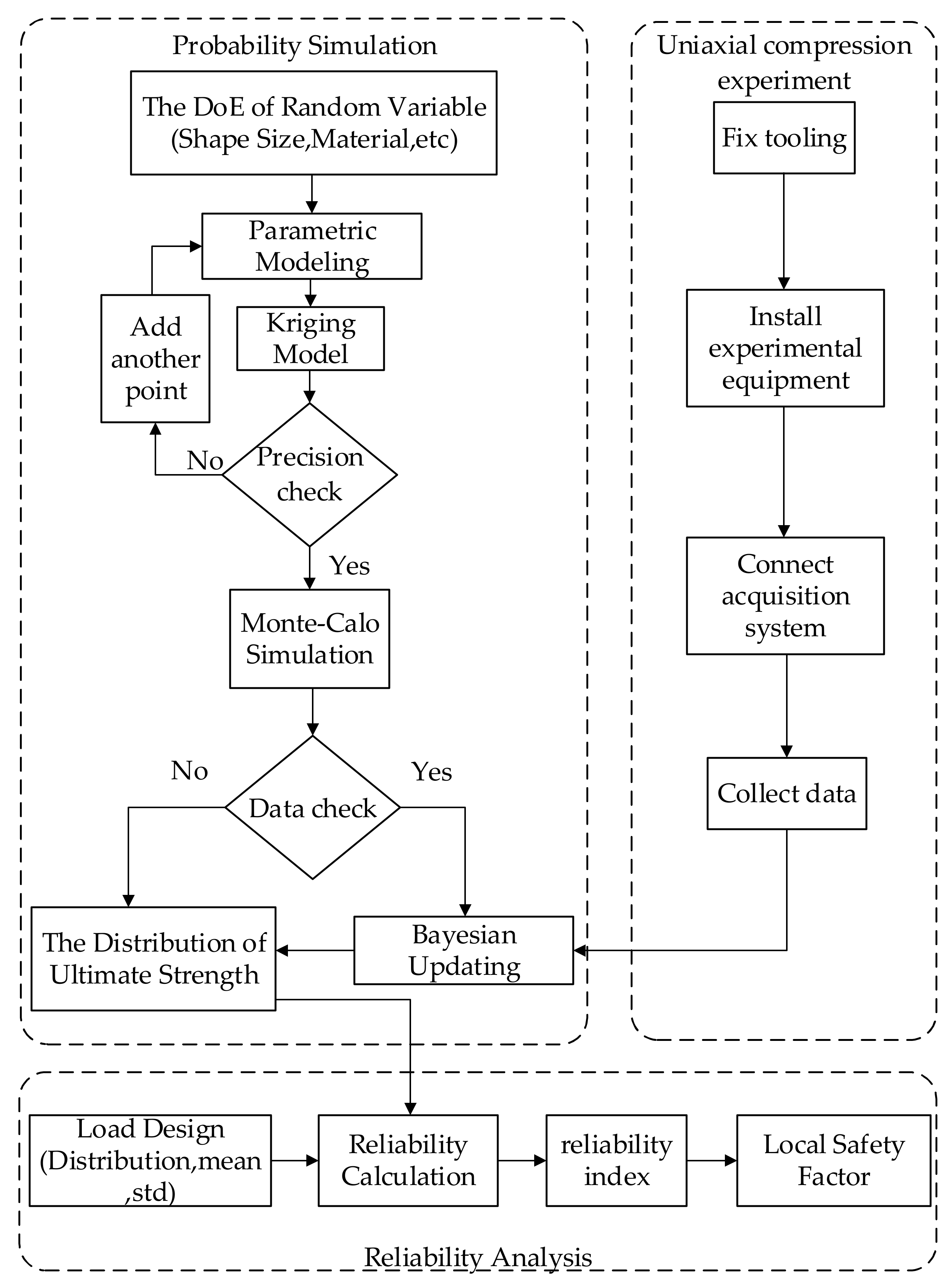
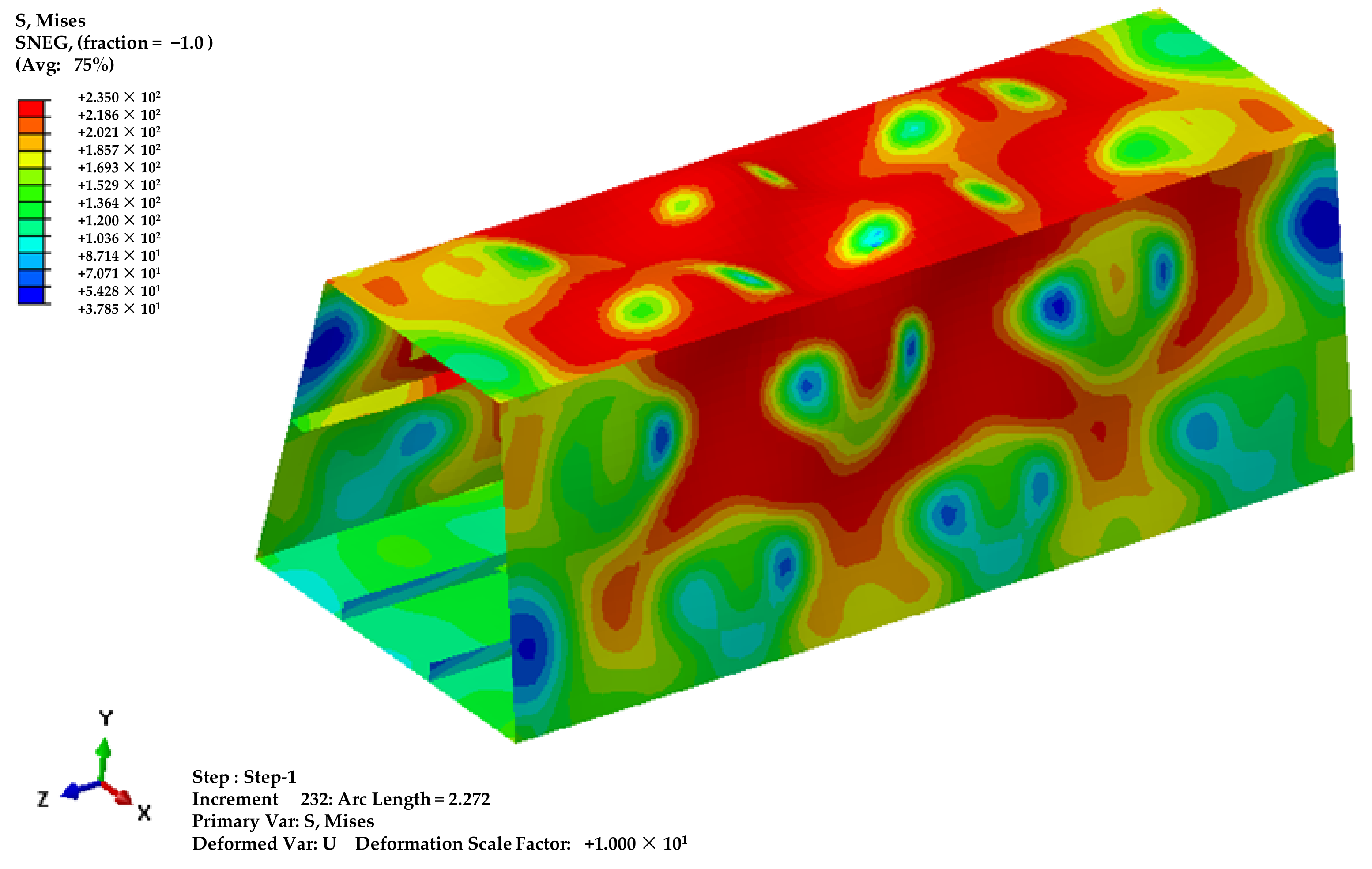
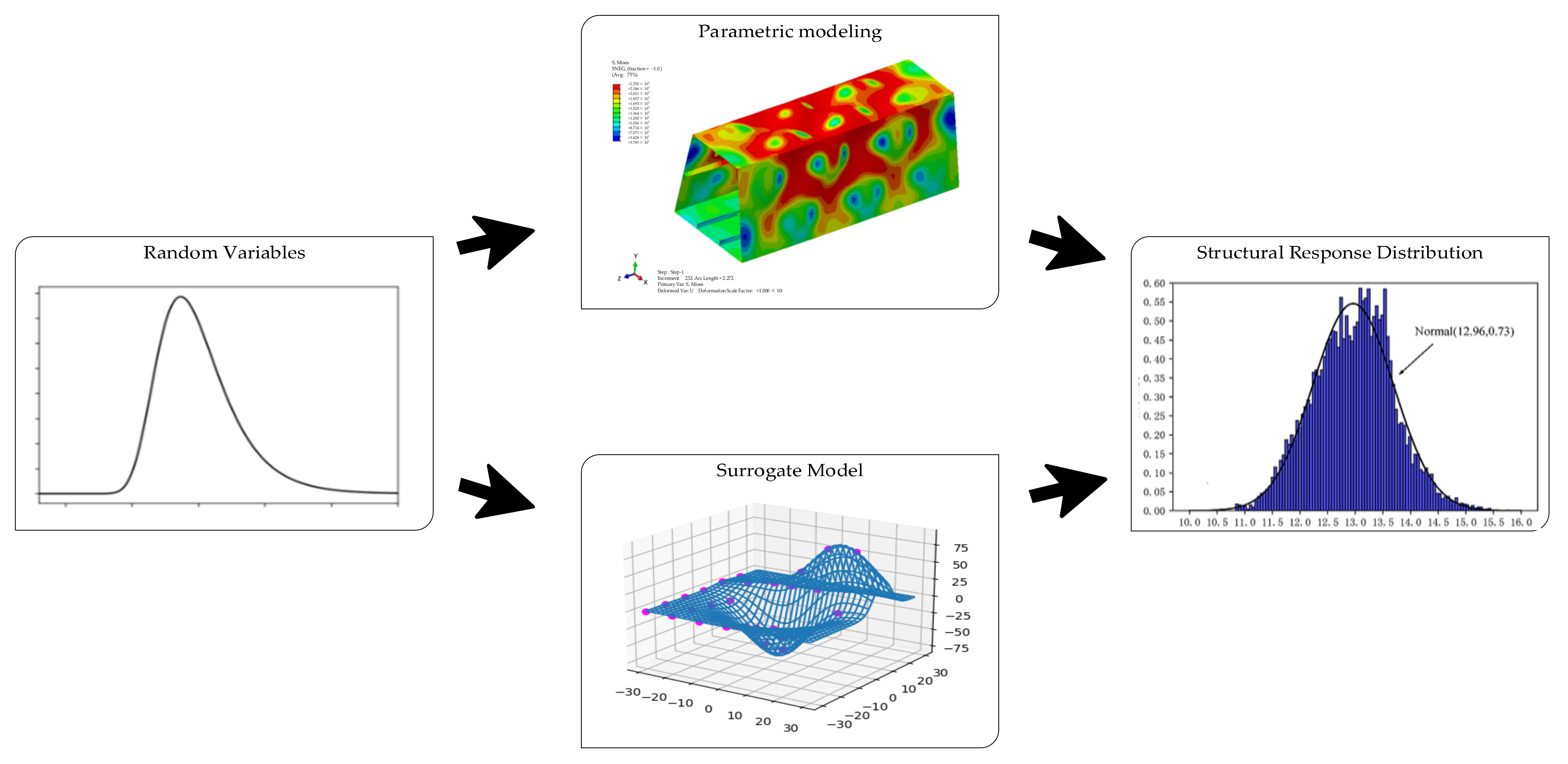
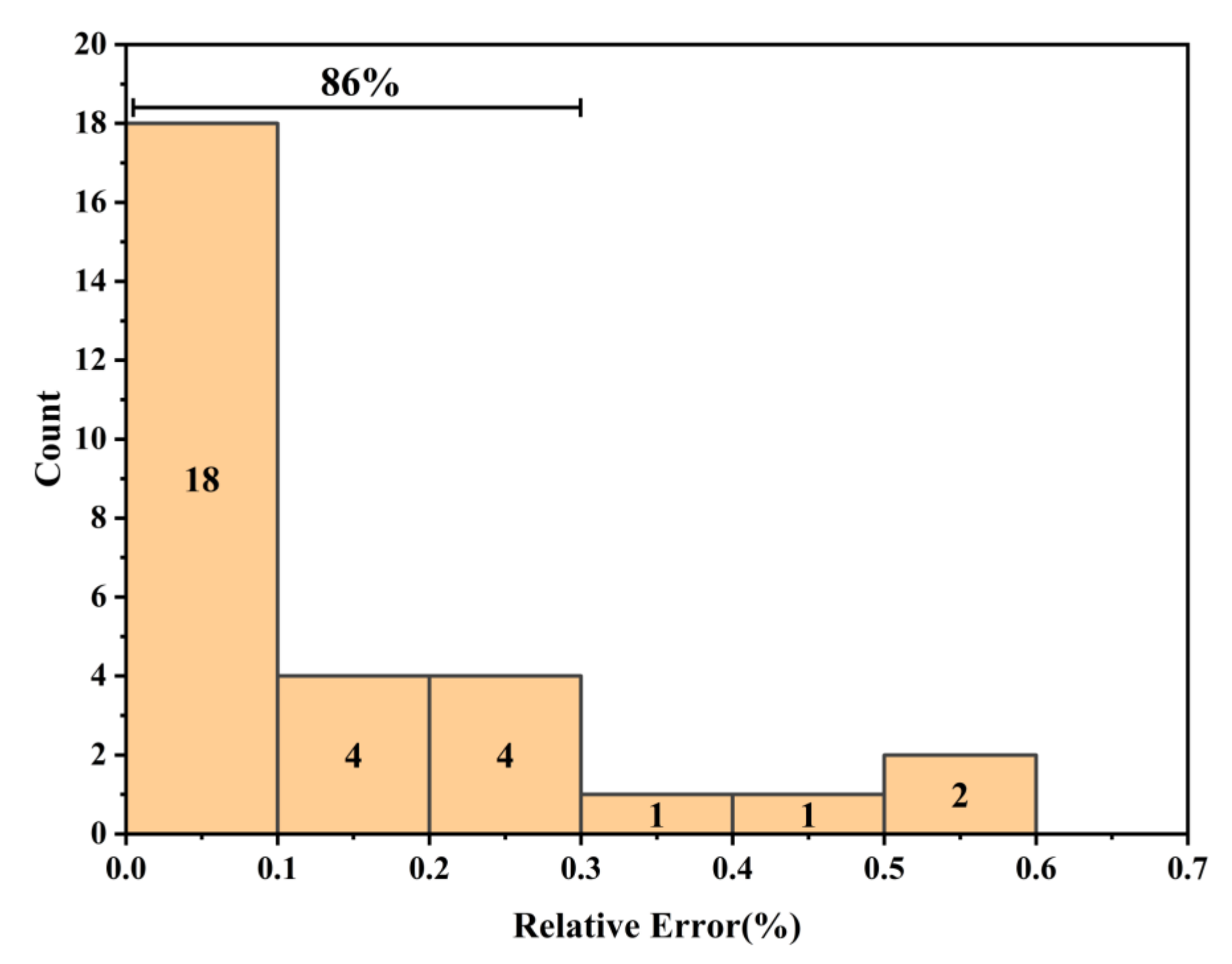

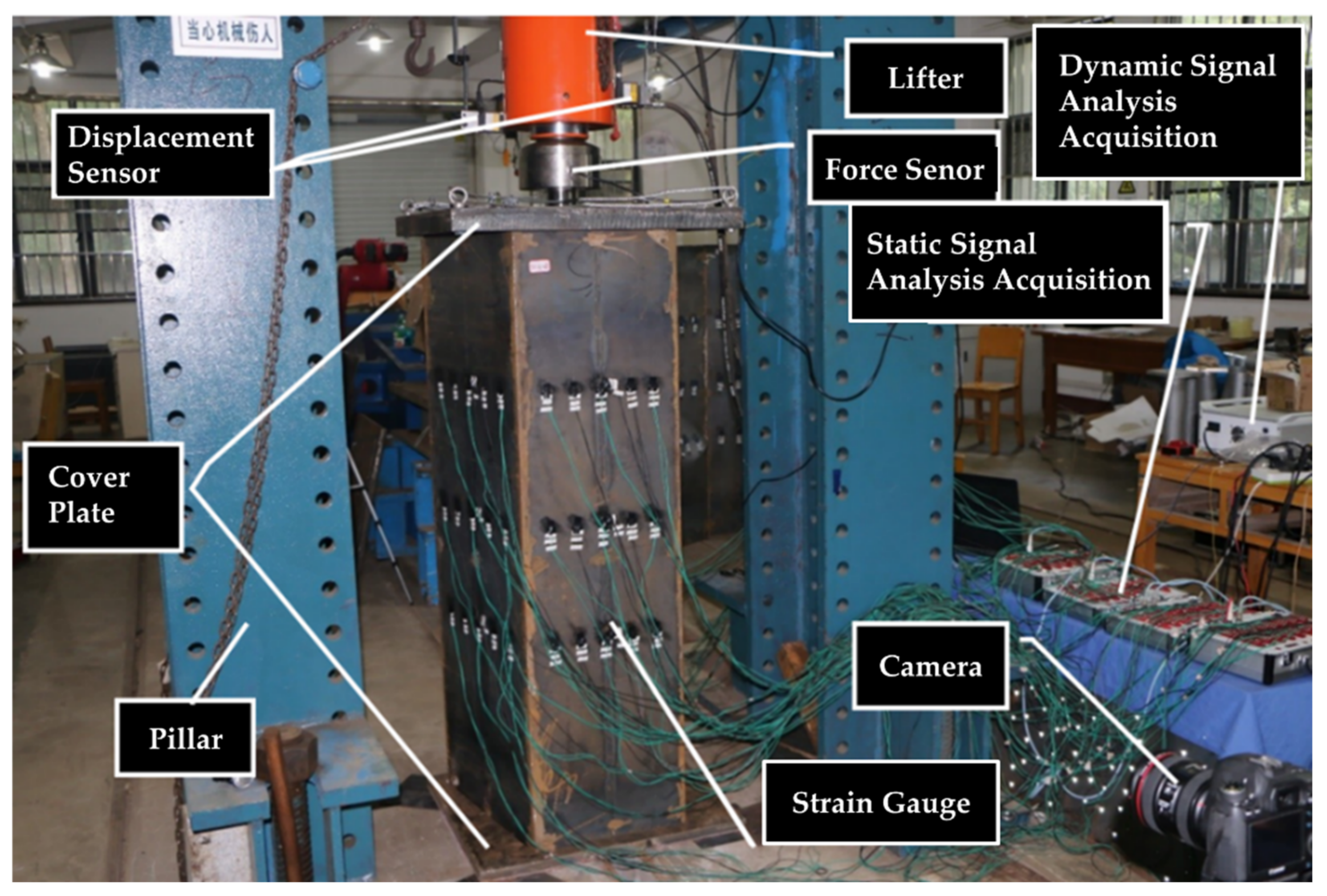

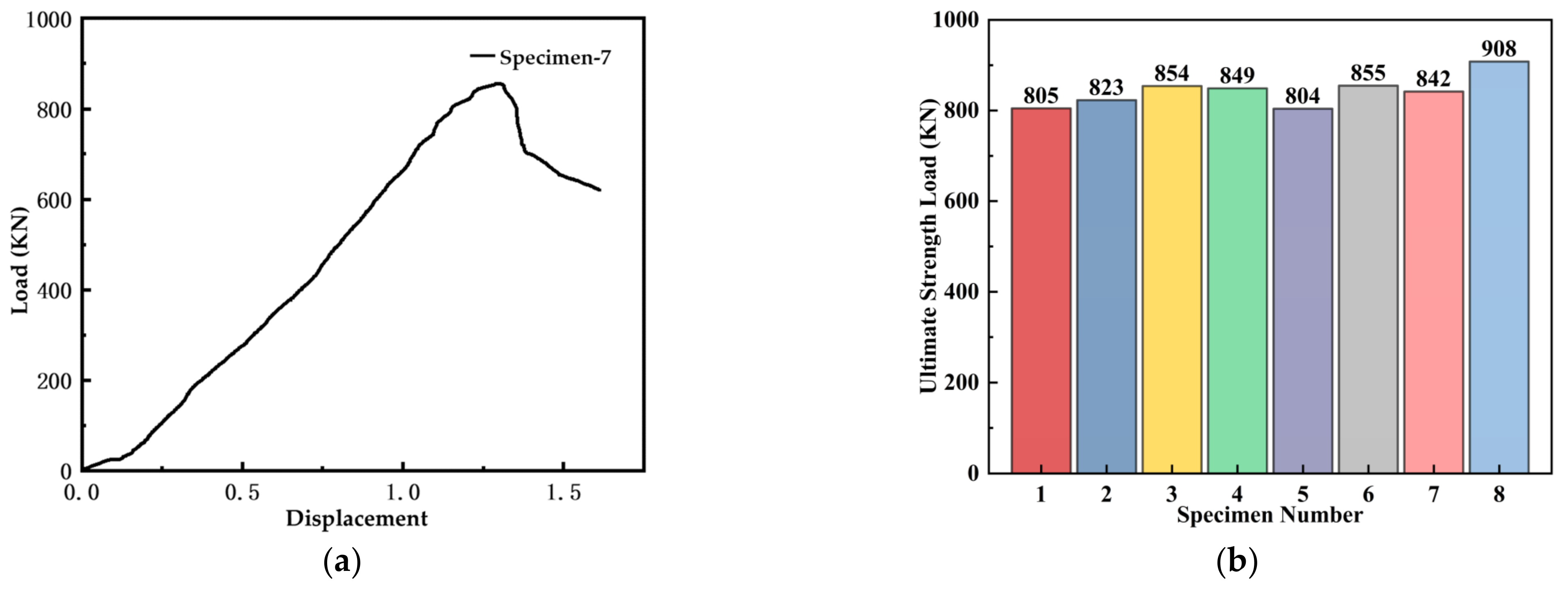
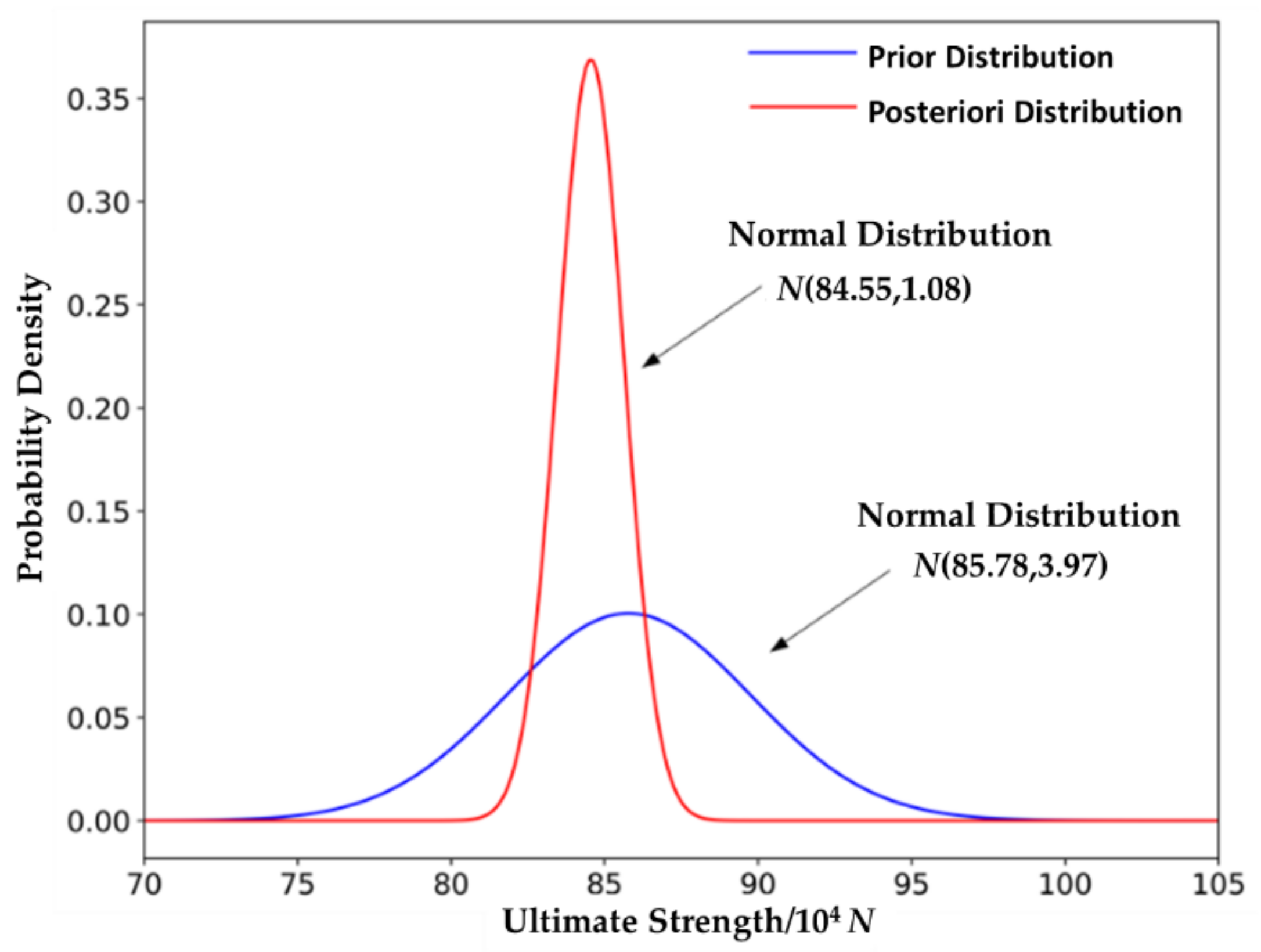
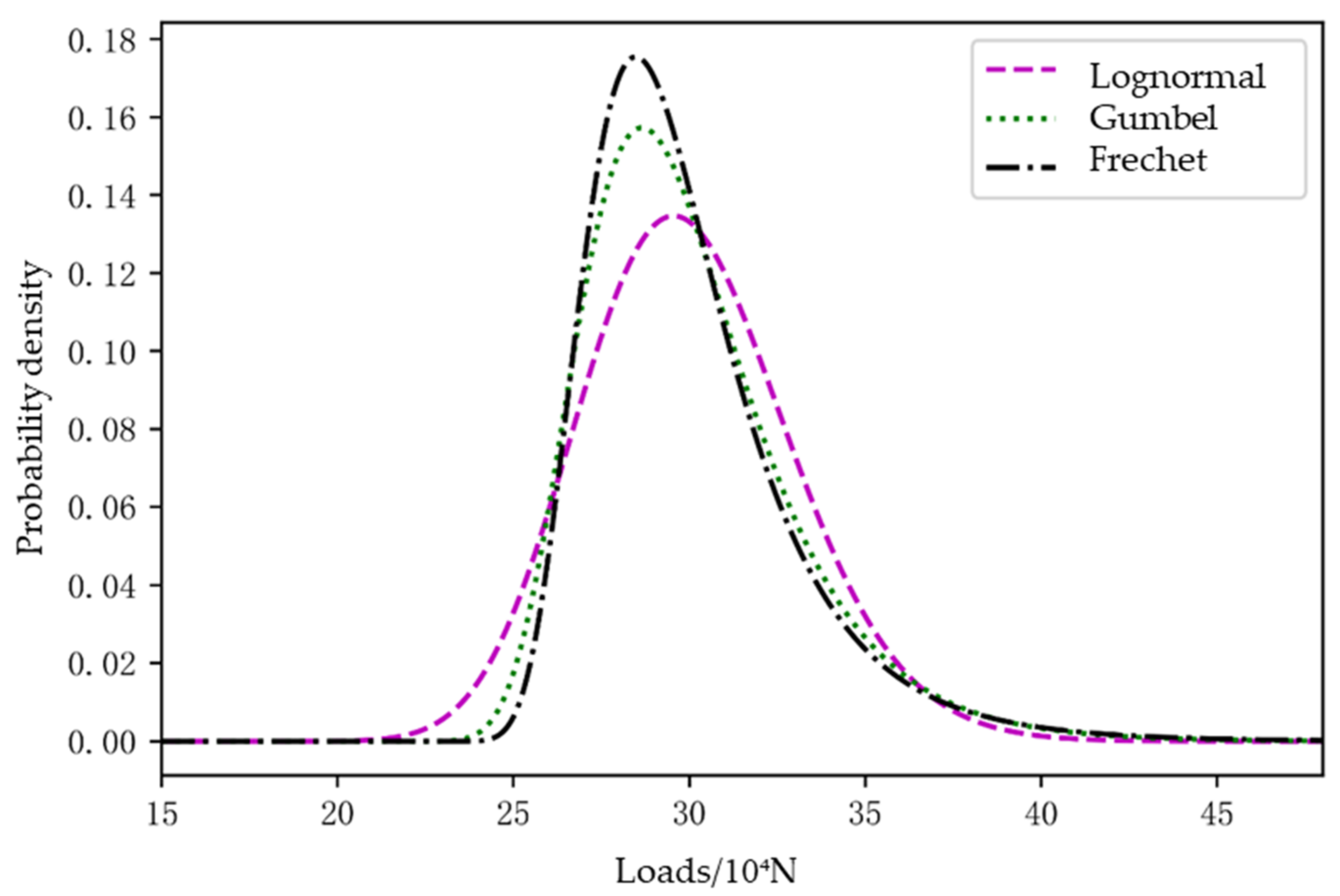
| Parameter | Unit | Data |
|---|---|---|
| Upper bottom width | mm | 400 |
| Bottom width | mm | 600 |
| Section height | mm | 500 |
| Overall length | mm | 1500 |
| Plate thickness | mm | 3 |
| Stiffener thickness | mm | 3 |
| Stiffener height | mm | 30 |
| Material | \ | Q235 |
| Random Variables | Distribution Type | Mean | Coefficient of Variation |
|---|---|---|---|
| stiffener height | normal | 30 (mm) | 0.03 |
| Young’ modulus | lognormal | 210,000 (MPa) | 0.03 |
| plate thickness | normal | 3 (mm) | 0.03 |
| stiffener thickness | normal | 3 (mm) | 0.03 |
| Statistical Parameters | Distribution Type | ||||
|---|---|---|---|---|---|
| mean: standard deviation: | Lognormal | 10.351 | 1.993 | 0.847 | 2.353 |
| Gumbel | 7.141 | 1.970 | 0.847 | 2.325 | |
| Frechet | 4.936 | 1.969 | 0.847 | 2.325 | |
| mean: standard deviation: | Lognormal | 7.491 | 1.600 | 0.907 | 1.764 |
| Gumbel | 4.949 | 1.582 | 0.907 | 1.744 | |
| Frechet | 4.107 | 1.582 | 0.907 | 1.744 | |
| mean: standard deviation: | Lognormal | 5.273 | 1.337 | 0.947 | 1.411 |
| Gumbel | 3.768 | 1.322 | 0.947 | 1.395 | |
| Frechet | 3.340 | 1.322 | 0.947 | 1.395 |
Publisher’s Note: MDPI stays neutral with regard to jurisdictional claims in published maps and institutional affiliations. |
© 2022 by the authors. Licensee MDPI, Basel, Switzerland. This article is an open access article distributed under the terms and conditions of the Creative Commons Attribution (CC BY) license (https://creativecommons.org/licenses/by/4.0/).
Share and Cite
Xiao, S.; Han, Y.; Zhang, Y.; Wei, Q.; Wang, Y.; Wang, N.; Wang, H.; Liu, J.; Liu, Y. A Reliability Analysis Framework of Ship Local Structure Based on Efficient Probabilistic Simulation and Experimental Data Fusion. Metals 2022, 12, 805. https://doi.org/10.3390/met12050805
Xiao S, Han Y, Zhang Y, Wei Q, Wang Y, Wang N, Wang H, Liu J, Liu Y. A Reliability Analysis Framework of Ship Local Structure Based on Efficient Probabilistic Simulation and Experimental Data Fusion. Metals. 2022; 12(5):805. https://doi.org/10.3390/met12050805
Chicago/Turabian StyleXiao, Shuming, Yang Han, Yi Zhang, Qikun Wei, Yifan Wang, Na Wang, Haodong Wang, Jingxi Liu, and Yan Liu. 2022. "A Reliability Analysis Framework of Ship Local Structure Based on Efficient Probabilistic Simulation and Experimental Data Fusion" Metals 12, no. 5: 805. https://doi.org/10.3390/met12050805
APA StyleXiao, S., Han, Y., Zhang, Y., Wei, Q., Wang, Y., Wang, N., Wang, H., Liu, J., & Liu, Y. (2022). A Reliability Analysis Framework of Ship Local Structure Based on Efficient Probabilistic Simulation and Experimental Data Fusion. Metals, 12(5), 805. https://doi.org/10.3390/met12050805






